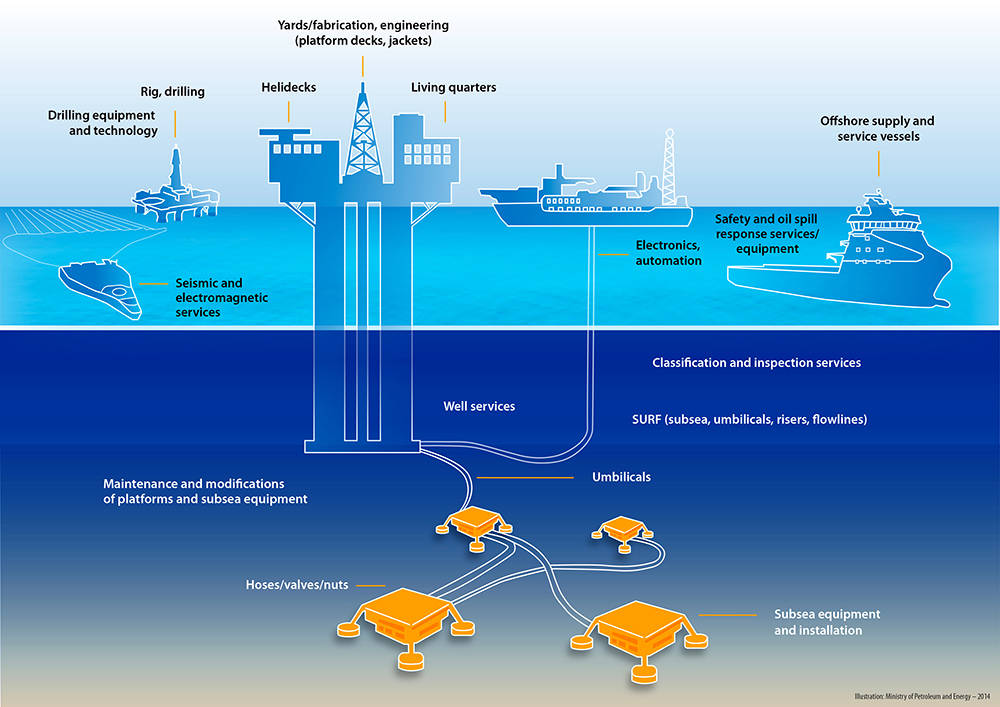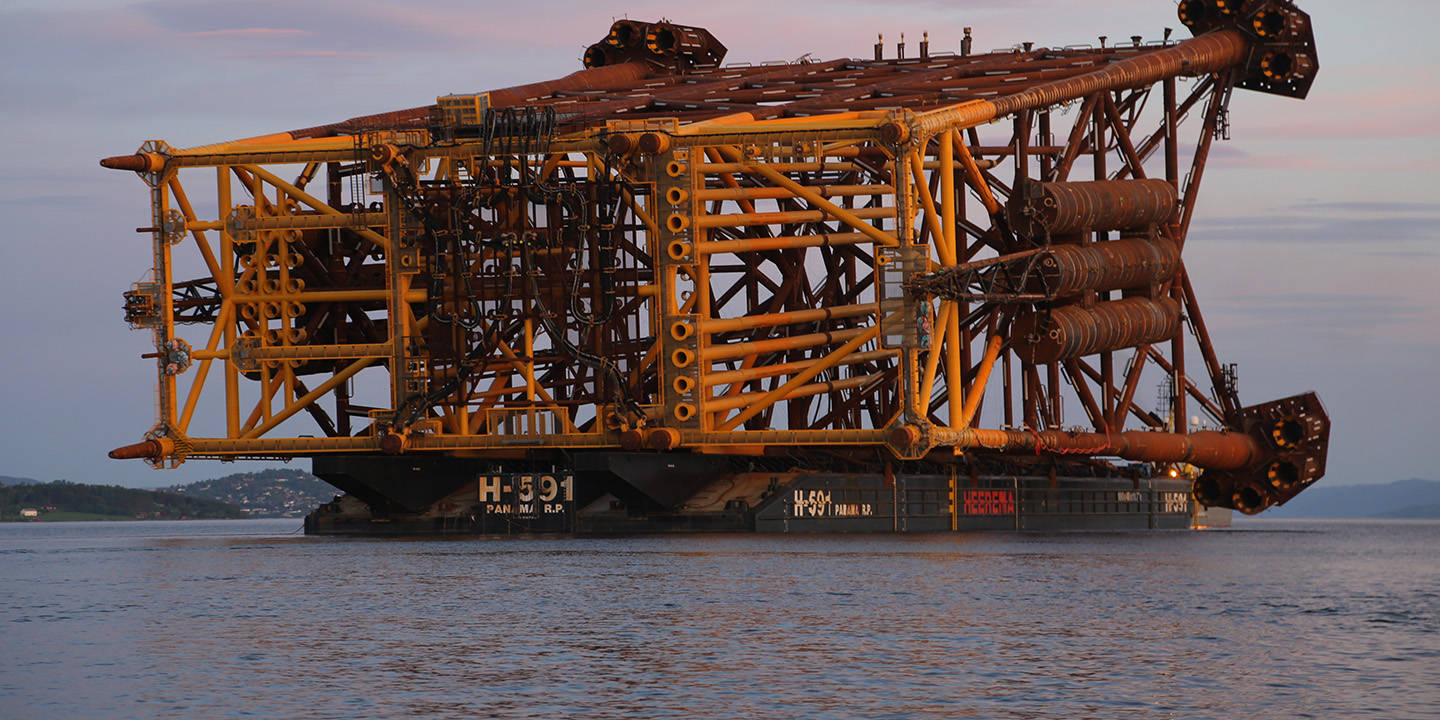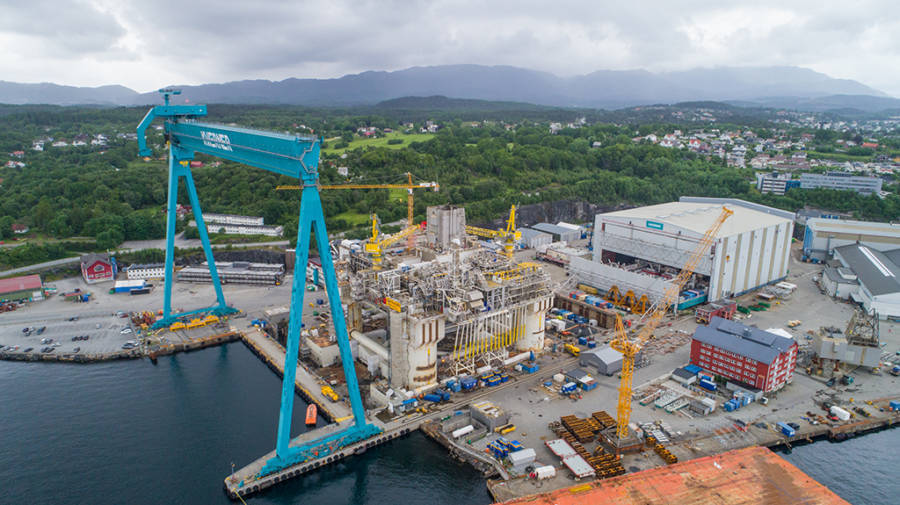Norway’s basis as a sophisticated industrial and shipping nation is one of the factors explaining how Norway managed to develop a world-leading, technologically advanced supply industry. Other factors include the need to handle challenging weather conditions in the North Sea, strict national legislation and HSE requirements, and high standards required by the operators. In many ways, the Norwegian continental shelf has functioned as a laboratory where companies have had to find new solutions and overcome technological challenges to be able to extract the petroleum resources.
The Norwegian continental shelf is one of the world’s largest offshore markets, providing a large domestic market for suppliers and a source of employment in all of Norway's counties.
According to a study by Kunnskapsparken Bodø with annual estimates of the petroleum-industry’s potential for value creation and employment in the northernmost counties in Norway (Nordland, Troms and Finnmark), 144 companies were suppliers of the petroleum industry in 2023, representative of 1727 man-years. Hammerfest had the most man-years with 714 employed. See the article on employment for more information.
For many years, the petroleum-based service- and supply industry have been in transition. Both as a result of challenges like the oil price decline in 2014 and the Covid-19 pandemic, and the increased focus on renewable energy and low-carbon solutions. The operators and the service and supply industry have managed to reduce costs and increase efficiency, resulting in profitable projects even at low oil prices. Even though this has been a demanding process, it was also necessary to stay competitive in the long run. As a demonstration of its adaptability and competitiveness, Norwegian suppliers have won several big contracts both in domestic and international markets
The Norwegian service and supply industry consists of roughly 2000 companies providing goods and services in all stages of the value chain.
For instance, in the discovery-phase there are companies providing seismic surveys, data processing, geological- and geophysical services, as well as drilling- and well-services. When a discovery is made, there will be demand for engineering services, platform solutions that needs to be developed at a yard and various types of equipment that has to be produced and installed.
Furthermore, production equipment needs to be placed and installed at the seabed, for then to be connected to the platform. In the operational phase, there will be demand for shipping services, maintenance- and other services. Since the production phase may last for many decades, it could also be relevant with larger upgrades, like new processing equipment and more wells. When it is no longer profitable to keep the field operating, the infrastructure must be disposed of.
Direct and indirect petroleum-related activity
The illustrations below shows the relationship between oil companies or operators (dark blue) and the different service and supply segments (light blue). The industry also consists of other services (orange), however, petroleum induced activity in these segments are not considered a part of the service and supply industry. (Source: International Research Institute of Stavanger (IRIS))

The petroleum-based services- and supply industry is located throughout Norway. The Stavanger-region employs the most and offers a wide range of services and goods. In other parts of the country, companies operating in the same market segment are clustered together based on their regional expertise.
In and around Oslo are well-established engineering expertise and a cluster of seismic companies. Trondheim has a strong position in education, research and development, while the Bergen region has become a hub for platform maintenance and subsea equipment. In Buskerud, especially in Kongsberg, is a strong cluster focusing on subsea technology, automation and dynamic positioning equipment. Southern Norway is home to world-leading companies specialising in drilling technology. The North-West of Norway has maritime companies that together make up a complete shipbuilding and outfitting cluster.
Technologies originally developed specifically for the petroleum sector are also applied in a range of other sectors, along with the service and supply industry's experience and expertise. One example is offshore wind – and floating offshore wind in particular. Another area utilising design principles and technology from the petroleum sector is open ocean aquaculture. Other examples include carbon capture and storage, water purification, sensors used in satellites, and medical research.
The Norwegian petroleum industry covers the entire supply chain
Sketch of a field during development and operation (Source: Ministry of Energy)

Rapid developments in subsea technology are making it possible to extract oil and gas at increasing depths and distances from land. Subsea solutions will play a vital role in the development of new discoveries in the Barents Sea.
Exciting new developments include a breakthrough in subsea compression technology in Norway. Equinor (former Statoil) has two seabed compression projects on the Åsgard and Gullfaks fields on the Norwegian shelf. The aim is to maintain the level of production as the pressure in the reservoirs drops. Equinor envisages the installation of this type of technology on more fields as a cost-effective way of increasing the recovery rate and prolonging field lifetime.
The Åsgard subsea compressor, delivered by Aker Solutions, is the first subsea compression system in the world. It will boost recovery from the Mikkel and Midgard reservoirs by 306 million barrels of oil equivalents. In developing the system, Aker Solutions drew on experience it gained during a pilot project on subsea compression on Ormen Lange.
The subsea wet gas compressor for Gullfaks is another example of cutting-edge technology, and was developed by OneSubsea in cooperation with Equinor. This is the first system of its kind in the world, and is expected to increase the recovery rate for Gullfaks Sør from 62 % to 74 %. This means that production will rise by 22 million barrels of oil equivalents. The compressor station was built and tested entirely by suppliers and subcontractors in Western Norway.
The Norwegian service and supply industry is active in offshore markets all over the world. In 2020, the industry had a total turnover of NOK 374 billion, of which NOK 109 billion or about 30 % came from international markets.
Subsea equipment and installation was the segment with the largest turnover internationally in 2020. This was followed jointly by the segment for Operations- and professional services, and topside- and processing equipment. The three largest markets measured in turnover in 2020 was the United Kingdom, USA and Brazil. The shipping nations Singapore and South Korea constitute important markets within well-packages and other equipment for platform and drilling.
The Norwegian petroleum-based supply- and services industry have for many years been transitioning as a result of changes in the market, first following the oil price decline in 2014 and now with the Covid-19 pandemic. Increased focus on climate and significant growth within renewable energy and low-carbon solutions are an important additional driver for the transition where particularly offshore wind has similar characteristics like the petroleum-based activity offshore. The activity associated with oil and gas will continue to be the foundation for the supply- and services industry for many years to come.
International revenues in the Norwegian service and supply industry 2020, 10 largest countries
Updated: 16.03.2022
Source: Rystad Energy
Print illustration Download data International revenues in the Norwegian service and supply industry 2020, 10 largest countries Download PDF Download as image (PNG)
High Contrast Mode
Exports of services and goods from the Norwegian-based energy industry is important for employment and value creation in Norway. Norwegian authorities have therefore contributed to more export-oriented policies that promotes Norwegian-based energy industries abroad. For instance is NORWEP, Norwegian Energy Partners, the Government’s most important policy organisation in this regard.
The foundation Norwegian Energy Partners (NORWEP) is a successful public-private partnership and was established by Norwegian authorities by the Norwegian Ministry of Foreign Affairs, Norwegian Ministry of Trade and Fisheries, and the Norwegian Ministry of Energy, in addition to The Norwegian Shipowners Association, Offshore Norge, Energy Norway, The Federation of Norwegian Industries, LO Norway, Equinor and Statkraft. NORWEP provides councelling in 26 important markets, in addition they offer a variety of services that are important for Norwegian-based companies with internaitonal operations. NORWEP has mandate to contribute to increaesd value creation and employment in Norway through the promotion of exports from all parts of the Norwegian-based energy industry. Read more here: www.norwep.com


